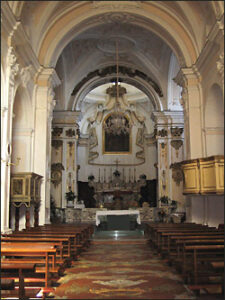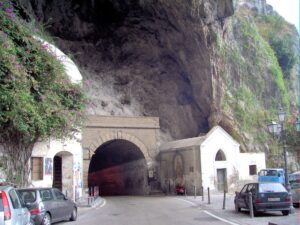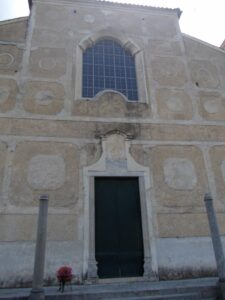MUNICIPALITY: Ravello
NAME: Cathedral Museum
LOCATION: Piazza Vescovado
DESCRIPTION: The museum, housed since July 3, 1983, in the Crypt of the Cathedral, home of the ancient Confraternity of the Body of Christ active from 1696 to 1935, consists of two rooms, the main one of which corresponds to the Crypt. It is divided into two naves by a row of six columns, with spolia capitals, and is preceded by a smaller room that represents the entrance to the museum and at the same time the first exhibition room. In this first room are in fact collected architectural elements of uncertain provenance and emblematic evidence of the reuse of pieces from the classical age in structures from the medieval period; among them are a marble entablature with dentils and ovoli and a series of Roman cinerary urns, recuperated from churches in the area, where they were used as fountains. The second room collects structural parts and works from the cathedral. Elements of considerable artistic importance also for the reconstruction of the building life of the church above are the parts that can be traced back to the ancient Ciborium built above the main altar, which was dismantled in ancient times because of its precarious structural condition and dismembered into its various parts. Of the Ciborium, a gift of Matteo Rufolo and the work of Matteo de Narna in 1279, the architraves survive and are preserved here. They are decorated with plant-inspired mosaic ornamentation, two small columns, two capitals, and a sculpture in the round, in white marble, representing an Agnus Dei contained in a circle with mosaic decoration and which is part of the cover of the ciborium itself.
But surely the most representative work of the cultural and artistic climate of 13th-century southern Italy is the so-called bust of Sigilgaita Rufolo. It reproduces, in white marble, a female face, adorned with a diadem that rests on a hairstyle fixed at the nape of the neck; the nobility of the representation, accentuated by a smile traceable to the archaic Greek type, makes it possible to resolve the long controversy over the identification of this female figure. She is not the wife of the donor of the ambo of the Duomo’s Gospel, Nicola Rufolo, as most people want, but the bust in the round would be the representation of the triumphant Church, especially since the presence of earrings of the barbarian type would be explanatory of the unifying function of the Church. Attributable to the Gospel ambo is a six-panel panel framed by stelliform mosaic motifs and reproducing phytomorphic and lily-like elements.
SEE, VISIT , FIND : The Museum can be visited daily from 9 a.m. to 7 p.m. (in summertime 8 p.m.)
FRUITION DATA: Over the chronological span of the last ten years, there has been a fluctuating trend in fruition, in quantitative terms, with a peak of 17799 visitors in the year 2003 distributed mainly in the months of May and September. In terms of quality, the highest percentage is made up of individual and occasional visitors who, after visiting the Cathedral above, complete their visit with the museum. Few among them are foreigners. The presence of groups is limited in number and time (for the year 2003 only in the months of May and October the percentage of groups was substantial), excluding from this type of visitors those from school trips, who although visiting the Cathedral do not use the museum.
OPPORTUNITIES: The enjoyment of the museum could be optimized through the collection in the same rooms of the artistic heritage of the newly established art gallery, housed in the Baroque church adjacent to the Cathedral and in communication with it. The creation of artistic itineraries, through guided tours of the Museum and the Cathedral above, could be an important attraction for visitors interested in the local artistic-cultural climate. Finally, multimedia aids for a more complete enjoyment of the site should be adopted.
BIBLIOGRAPHY: The Museum has its own website within that of the Cathedral.




